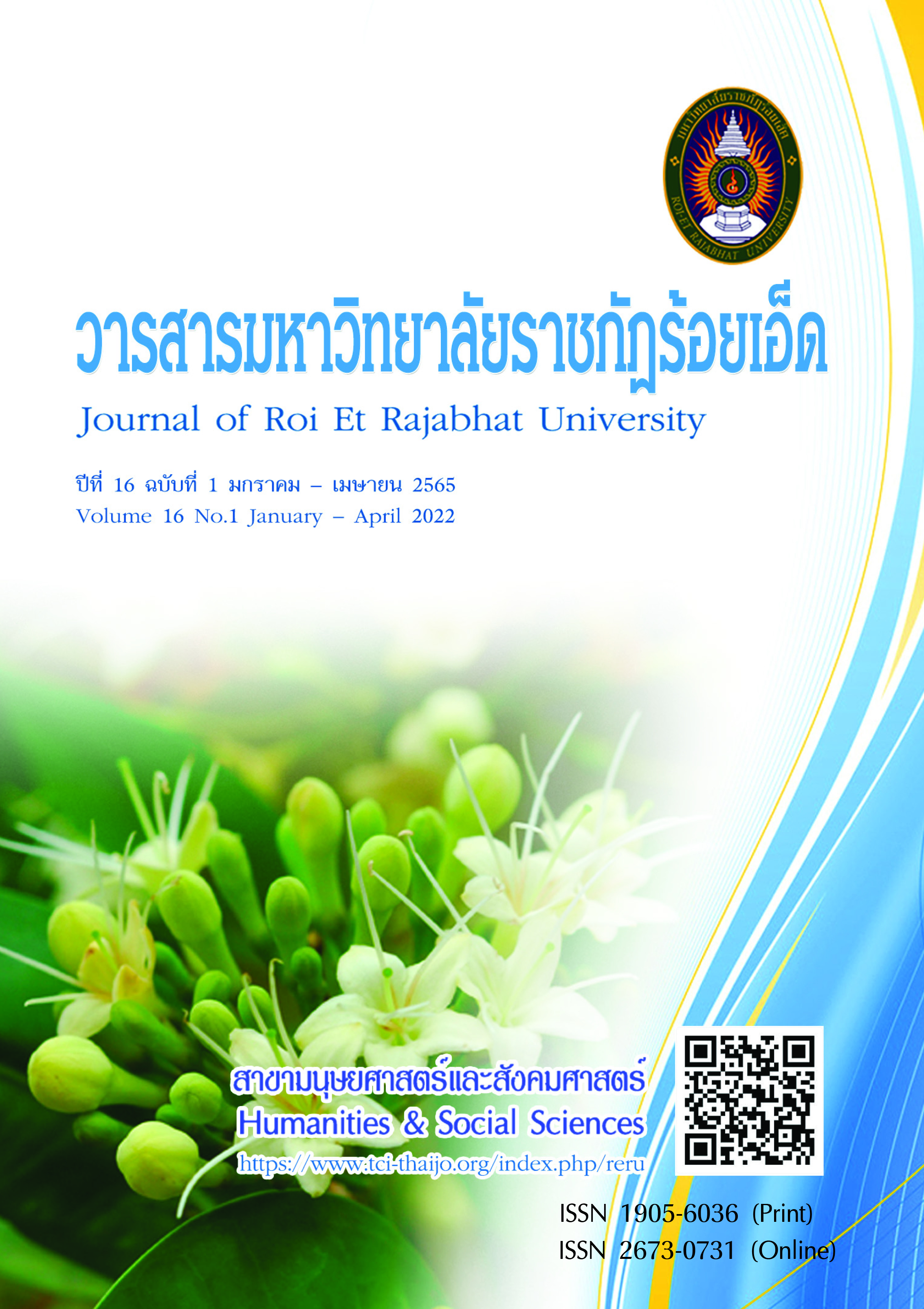The Development of MALAE Learning Model for Promoting English Reading Comprehension and Analytical Thinking Skills of Mattayomsuksa 5 Students
Keywords:
Development of Learning Model, English Reading Comprehension, Analytical Thinking SkillsAbstract
The purposes of this research aimed to: 1) develop the MALAE Learning Model for Promoting English reading comprehension and analytical thinking skills of Mattayomsuksa 5 students; 2) study an effectiveness of MALAE Learning Model. The procedure of this study included 4 phases. Phase 1- Studying and analyzing primary data, students’ opinions in order to form a basis for the development of the MALAE Learning Model. Phase 2 – Creating and develop the MALAE Learning Model according to the related documents on learning English comprehension and analytical thinking skills. Then the form of MALAE Learning Model was assessed by 5 experts. The data were analyzed by using mean and standard deviation. Phase 3 – Creating and develop the research instruments were the lesson plans for MALAE Learning Model, an English reading comprehension test, an analytical thinking test, and a student satisfaction assessment form. Phase 4 – Studying an effectiveness of MALAE Learning Model, the sample of the study consisted of 40 students at Mattayomsuksa 5/2 students enrolling in the class at Buakhao School, Kalasin Province, in the second semester of the academic year 2019. The sample was selected through a cluster random sampling method. The obtained data were analyzed by percentage, mean, standard deviation and dependent t – test. The research findings were as follows: 1) The MALAE Learning was consists of principle theories and fundamental concepts, objective, contents, learning processes, measurement and evaluation and important conditions for success. This model consisted of 5 sequential steps which were 1) Motivating (M), 2) Analyzing (A), 3) Learning Together (L), 4) Applying Thinking Process (A) , and 5) Evaluating (E). The efficiency of the MALAE Learning Model met the criterion of 85.05/84.50 that was higher than the required criterion. 2) The effectiveness of the MALAE Learning Model shown that; 2.1) The students who had participated the MALAE Learning Model increased significantly their learning achievement of post-test of English reading comprehension higher than the pre-test at the .05 level. 2.2) The students who had participated the MALAE Learning Model increased significantly their analytical thinking abilities at the .05 level. And 2.3) the overall students’ satisfaction towards the MALAE Learning Model was at the highest level ( = 4.72, S.D. = 0.45)
References
กระทรวงศึกษาธิการ. (2555). แนวทางการจัดกิจกรรมการเรียนรู้ เพื่อพัฒนาทักษะการคิดตามหลักสูตรแกนกลางการศึกษาขั้นพื้นฐาน พุทธศักราช 2551 กลุ่มสาระการเรียนรู้ภาษาต่างประเทศ ระดับมัธยมศึกษา (พิมพ์ครั้งที่ 2).
กรุงเทพฯ: โรงพิมพ์ชุมนุมสหกรณ์การเกษตรแห่งประเทศไทย จำกัด.
กุลธิดา ท้วมสุข, ดารารัตน์ คำภูแสน, อังคณา ทองพูฆน พัฒนศร, กรวิภา พูลผล และอุทัยวรรณ ด่านวิวัฒน์. (2560). รายงานการวิจัย เรื่อง การพัฒนารูปแบบการสอนภาษาอังกฤษ เพื่อการสื่อสารสำหรับการศึกษาขั้นพื้นฐานในภาคตะวันออกเฉียงเหนือ. ขอนแก่น: มหาวิทยาลัยขอนแก่น.
เกรียงศักดิ์ เจริญวงศ์ศักดิ์. (2546). การคิดเชิงวิเคราะห์. กรุงเทพฯ: ซัคเซสมีเดีย.
เกรียงศักดิ์ เจริญวงศ์ศักดิ์. (2551). พัฒนาคุณธรรมผู้เรียนครบวงจร-เส้นทางที่ต้องก้าวเดิน. วารสาร วัฒนธรรมไทย, 47(6), 46-48.
จิรา ลังกา. (2558). การพัฒนารูปแบบการจัดการเรียนรู้เพื่อเสริมสร้างความสามารถในการอ่านภาษาอังกฤษอย่างมีวิจารณญาณของนักเรียนชั้นมัธยมศึกษาปีที่ 5: การวิจัยปฏิบัติการ. ดุษฎีนิพนธ์ ปรัชญาดุษฎีบัณฑิต สาขาวิชา
หลักสูตรและการสอน. มหาสารคาม: มหาวิทยาลัยมหาสารคาม.
ทิศนา แขมมณี. (2556). รูปแบบการเรียนการสอน: ทางเลือกที่หลากหลาย (พิมพ์ครั้งที่ 8). กรุงเทพฯ: จุฬาลงกรณ์ มหาวิทยาลัย.
ทิศนา แขมมณี, เฉลิมชัย พันธ์เลิศ และภาษิต ประมวลชัยศิลป์. (2548). การจัดการเรียนรู้โดยใช้ รูปแบบซิปปา CIPPA MODEL. กรุงเทพฯ: พัฒนาคุณภาพวิชาการ.
ธูปทอง กว้างสวาสดิ์. (2554). การสอนการคิด. กรุงเทพฯ: ข้าวฟ่าง.
รพีพรรณ เชื้อจันอัด, นพคุณ ภักดีณรงค์ และนฤมล อเนกวิทย์. (2557). การพัฒนารูปแบบการสอนอ่านภาษาอังกฤษเพื่อความเข้าใจตามทฤษฎีไวกอทสกี สําหรับนักเรียนชั้นมัธยมศึกษาปีที่ 1. คณะศึกษาศาสตร์ มหาวิทยาลัยมหาสารคาม, 21(2), 266-279.
ลัดดา หวังภาษิต. (2557). การพัฒนารูปแบบการเรียนรู้ภาษาอังกฤษที่เสริมสร้างความสุขในการเรียนรู้ของนักเรียนชั้นประถมศึกษา โรงเรียนสาธิตสังกัดสำนักงานคณะกรรมการการอุดมศึกษา. ดุษฎีนิพนธ์ การศึกษาดุษฎีบัณฑิต สาขาวิชาการวิจัยและพัฒนาหลักสูตร. กรุงเทพฯ: มหาวิทยาลัยศรีนครินทรวิโรฒ.
วัชรา เล่าเรียนดี. (2555). รูปแบบและกลยุทธ์การจัดการเรียนรู้เพื่อพัฒนาทักษะการคิด (พิมพ์ครั้งที่ 9). นครปฐม:
มหาวิทยาลัยศิลปากร.
วิภาดา พูลศักดิ์วรสาร. (2555). การพัฒนารูปแบบการสอนอ่านเน้นภาระงานโดยใช้กลวิธีอภิปัญญาสำหรับผู้ใหญ่
เพื่อส่งเสริมความเข้าใจในการอ่านภาษาอังกฤษ. ดุษฎีนิพนธ์ ปรัชญาดุษฎีบัณฑิต สาขาวิชาหลักสูตรและการสอน. นครปฐม: มหาวิทยาลัยศิลปากร.
วิสาข์ จัติวัตร์. (2543). การสอนอ่านภาษาอังกฤษ (พิมพ์ครั้งที่ 2). กรุงเทพฯ: มหาวิทยาลัยศิลปากร.
สถาบันภาษาอังกฤษ สำนักงานคณะกรรมการการศึกษาขั้นพื้นฐาน. (ม.ป.ป.) คู่มือการจัดการเรียนการสอน ภาษาอังกฤษแนวใหม่ ตามกรอบมาตรฐานความสามารถทางภาษาอังกฤษที่เป็นสากล ระดับชั้นมัธยมศึกษา. กรุงเทพฯ:
องค์การสงเคราะห์ทหารผ่านศึก.
สุทัศน์ สังคะพันธ์. (2559). การพัฒนารูปแบบการจัดการเรียนรู้เพื่อเสริมสร้างความสามารถด้านการสื่อสารในการฟัง และการพูดภาษาอังกฤษของนักเรียนชั้นประถมศึกษาปีที่ 4. ดุษฎีนิพนธ์ ปรัชญาดุษฎีบัณฑิต สาขาวิชาหลักสูตรและการสอน. มหาสารคาม: มหาวิทยาลัยมหาสารคาม.
สำนักงานเลขาธิการสภาการศึกษา. (2560). สภาวะการศึกษาไทย ปี 2558/2559 ความจำเป็นของการแข่งขัน
และการกระจายอำนาจในระบบการศึกษาไทย. กรุงเทพฯ: 21 เซ็นจูรี่.
สำนักงานเลขาธิการสภาการศึกษา. (2560). สมรรถนะการศึกษาไทยในเวทีสากลปี 2559 (IMD 2016). กรุงเทพฯ: 21 เซ็นจูรี่.
สำนักงานเลขาธิการสภาการศึกษา. (2560). แผนการศึกษาแห่งชาติ (พ.ศ. 2560-2579) ฉบับสรุป. กรุงเทพฯ:
พริกหวานกราฟฟิค.
สำนักงานเลขาธิการสภาการศึกษา. (2561). สภาวะการศึกษาไทย ปี 2559/2560 แนวทางการปฏิรูปการศึกษาไทยเพื่อก้าวสู่ยุค Thailand 4.0. กรุงเทพฯ: สกสค.
อุษา มะหะหมัด. (2557). การพัฒนารูปแบบการสอนอ่านภาษาอังกฤษเน้นภาระงานเพื่อเสริมสร้างทักษะ การคิดวิเคราะห์ สำหรับนักเรียนชั้นประถมศึกษา. ดุษฎีนิพนธ์ ปรัชญาดุษฎีบัณฑิต สาขาวิชาหลักสูตรและการสอน. นครปฐม: มหาวิทยาลัยศิลปากร.
Cao, Y. (2011). Investigating situational willingness to communicate within second language classroom from ecological perspective. Fuel and Energy Abstracts, 39(4), 468-479.
Devine, T.G. (1986). Teaching Reading Comprehension. Boston: Allyn & Bacon.
Dick, W., Carey, L. and Carey, J.O. (2005). The systematic design of instruction (6th ed.) Boston: Allyn & Bacon.
Gunning, T. G. (1992). Creating Reading Instruction for All Children. Allyn & Bacon. Division of Simon & Schuster Inc.
Johnson, K. (1982). Five Principles in a ‘communicative’ exercise type in K. Johnson. Communicative Syllabus Design and Methodology. Oxford: Pergamon.
Joyce, B., Weil, M. and Calhoun, E. (2009). Models of Teaching (8th ed.). New York: Allyn & Bacon.
Kruse, K. (2007). Introduction to instructional design and the ADDIE Model [electronic version].
Retrieved August 10, 2015, From http://www.e-learningguru.com/articles/art1_1.htm
Marzano, R. J. and John S. K. (2007) .The new Taxonomy of educational objectives (2nd ed.). California: Corwin Press.
Nunan, D. (1989). Designing tasks for the communicative classroom. Glassgrow: Bell and Bain.
Obah, T.Y. (1983). Prior Knowledge and the Quest for New Knowledge: The Third World Dilemma. Journal of Reading, 27(11), 129-133.
Shin, H. and Graham, C. (2005). Indigenous critical traditions for TEFL? A historical comparative
perspective in the case of Korea. Critical Inquiry in Language Studies, 2(2), 95-112.
Willis, J. (2000). A framework for tasked-based learning. Oxford: Longman Handbook.
Downloads
Published
How to Cite
Issue
Section
License
Copyright (c) 2022 Roi Et Rajabhat University

This work is licensed under a Creative Commons Attribution-NonCommercial-NoDerivatives 4.0 International License.
บทความที่ได้รับการตีพิมพ์เป็นลิขสิทธิ์ของวารสารมหาวิทยาลัยราชภัฎร้อยเอ็ด
ข้อความที่ปรากฏในบทความแต่ละเรื่องในวารสารวิชาการเล่มนี้เป็นความคิดเห็นส่วนตัวของผู้เขียนแต่ละท่านไม่เกี่ยวข้องกับมหาวิทยาลัยราชภัฎร้อยเอ็ด และคณาจารย์ท่านอื่นๆในมหาวิทยาลัยฯ แต่อย่างใด ความรับผิดชอบองค์ประกอบทั้งหมดของบทความแต่ละเรื่องเป็นของผู้เขียนแต่ละท่าน หากมีความผิดพลาดใดๆ ผู้เขียนแต่ละท่านจะรับผิดชอบบทความของตนเองแต่ผู้เดียว





